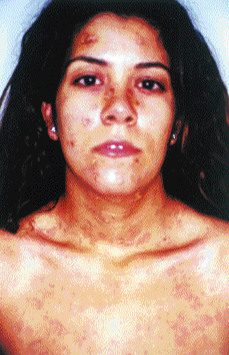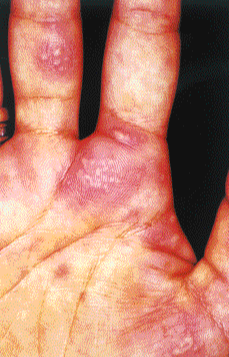INTRODUCTION
It is not very surprising to see a local or rarely systemic reaction during the course of specific immunotherapy (SIT) for allergy to house dust mites, pollens or other allergens. This type of reactions have been reported to develop after a few minutes and disappear within a few days after the injection. Rarely, some unusual reactions like subcutaneous fibrosis and late reactions caused by physical exercise have been reported as case reports in the literature (1, 2). To our knowledge, there are no papers in the literature reporting erythema multiforme due to SIT.
CASE REPORT
A 25-year-old female patient presented with a complaint of blistering lesions on her face, neck, chest and extremities appearing after SIT. Her history revealed that she had had perennial rhinoconjunctivitis for 15 years and she has started to receive SIT (mixture of mites: D. pteronyssinus and D. farinea; and mould mixture: Alternaria, Cladosporium, Aspergillus spp.; Stallergens, France) after having been determined of mite and mould sensitivity with allergic examination and tests in an allergy clinic. She has received the first dose of the SIT in the afternoon 17 days before her referral day. The next morning she has waken up with edema on her lips, tongue and the mucosa of cheeks and eroded lesions on her oral mucosa. In two days time blistering lesions has appeared on her face, neck and various parts of her body. She has also had small blistering lesions on the injection and the skin prick test sites. The patient has been prescribed loratadine tablet once daily, tetracycline tablet 500 mg four times daily, fucidate sodium creme and dexbropheniramine maleate tablet once daily. She had referred to our clinic after getting no response to the suggested medications on the 17th day of the SIT injection. She did not have history of familial atopy. She has had a dog at home for three years.
Physical examination revealed blistering lesions mainly located on her face, neck, chest, back, palms and soles (figs. 1 and 2). The lesions were symmetrical, circular, wheal-like erythematous plaques, peripheral part being edematous and the central crusted or vesicular. Her oral mucosa was moderately involved with eroded lesions. She also had crusts on the volar face of her left arm on the site of the skin prick tests. The diagnosis of erythema multiforme was confirmed by the dermatology consultation.
Figure 1.--Generalized lesions of erythema multiforme.
Figure 2.--Local lesion on the hand.
Laboratory examination revealed a normal complete blood count with a sedimentation rate of 18 mm/hr. Total blood chemistry was within normal limits. ANA, romatoid factor and C-reactive protein were all negative.
Prednisolone 40 mg/day in a single dose was started with a diagnosis of erythema muliforme as suggested by the dermatologists. Her lesions improved within 7 days and prednizolone was stopped after a week. The patient was suggested to use nasal budesonide for her perennial rhinitis and to stop receiving SIT.
DISCUSSION
Erythema multiforme is a disease spectrum that comprises a group of acute self-limited intolerance reactions that can be elicited by a wide spectrum of potential trigger factors. Antigens mainly involved are microbial (viruses) or drugs leading to cytotoxic immunologic attack on keratinocytes (3). This is the first case in the literature appearing due to SIT. She has not received any drugs on the day of the SIT. EM appearing right after SIT together with angioedema and blistering lesions also on the site of the skin prick tests shows that this clinical picture is the result of SIT. It should be kept in mind that unusually also this type of reactions can appear after SIT.







